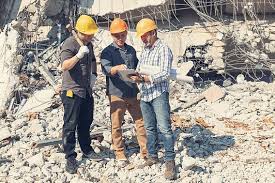Advertisement
When catastrophe strikes, the path to recovery isn’t just about rebuilding, it’s about rethinking every piece of the puzzle. From structural integrity to environmental hazards to connecting strategy with execution, every part must align. A true multidisciplinary approach, as demonstrated by experts at http://www.vertexeng.com, is the linchpin in turning devastation into renewal.
Why One Field Can’t Tackle It Alone
When a hurricane floods a commercial complex or a wildfire consumes an industrial site, the damage isn’t confined to one discipline. The structural engineer needs to understand the underlying geological risks, the remediation scientist must coordinate with construction teams, and the builder must know the insurance claim implications. It’s all connected.
1. Engineers Bring Stability and Safety
Structural engineers assess catastrophic events and determine load‑bearing failures, weakened beams, and compromised foundations. They design new frameworks that meet updated codes. Forensic structural engineers, architects, and environmental scientists combine to make sense of the damage and plan for a safer rebuild.
Fun fact: In 1906, after the San Francisco earthquake, engineers identified “soft‑story” buildings (ground floor weaker than upper floors), which helped reshape building codes.
2. Scientists Illuminate the Hidden, Complex Risks
Scientists – geologists, environmental chemists, and industrial hygienists – are key in disaster recovery. They map contamination after floodwaters hit, analyze wildfire smoke residue, and trace structural collapse back to material fatigue or fire damage. Environmental and industrial hygiene professionals deploy rapidly in catastrophic scenarios.
Fun fact: After the 1989 Loma Prieta earthquake, scientists discovered liquefaction in unexpected zones, where wet soil turned suddenly into a fluid‑like state under shaking.
3. Builders and Construction Pros Turn Plans into Reality
Once scientists and engineers define what happened and what needs to be done, builders execute. They manage contractors, sequence the work, liaise with insurers, and keep track of the schedule and cost. The “owner’s representation” role is often tasked with coordinating subcontractors, timelines, and the myriad challenges of the rebuild.
Fun fact: The world’s tallest modular building (built off‑site and assembled on‑site) was constructed in under five months – showing how the “build” side is evolving rapidly.
How a Multidisciplinary Team Actually Works
When all three disciplines, engineering, science, and construction, are aligned, recovery becomes structured, responsive, and resilient. Here’s a breakdown of how they collaborate:
- Immediately after the event: Scientists assess hazards (e.g., chemical spills, air quality); engineers survey structural damage; builders secure the site for safe access.
- Mid‑phase: Engineers design repair and retrofit plans; scientists develop remediation and environmental safety protocols; builders manage procurement, schedules, and budgets.
- Final phase: Builders execute reconstruction; scientists monitor long‑term environmental and indoor-air quality; engineers certify structural integrity and code compliance.
Specialized teams with a broad range of expertise emphasize rapid deployment and multidisciplinary support in post-catastrophic response.
Benefits of the Unified Approach
- Faster recovery: By combining expertise upfront, fewer delays arise from unexpected hazards or rework.
- Cost‑control: Engineers assess repairs precisely; scientists avoid hidden liabilities; builders optimize scheduling and materials.
- Improved resilience: The rebuilt infrastructure isn’t just “back to pre‑failure” but often upgraded with resilience (better fire systems, more robust foundations, hazard‑aware materials).
- Higher trust: For property owners, insurers, and communities, seeing a coordinated team of experts gives confidence in the process and the outcome.
Real‑World Insight: Why the Right Response Matters
Consider a wildfire scenario: It’s not enough to clear the charred remains and rebuild. Science must evaluate smoke damage, soil erosion risk, and water intrusion from firefighting efforts; engineering must check structural members compromised by fire; construction must implement fire‑resistant materials and modern code upgrades. That kind of comprehensive approach is key to effective catastrophe recovery.
Fun fact: Some wildfires cause “pyro‑clouds” so large they create their own weather systems – meaning the rebuild must account for unpredictable fire behavior.
Disaster recovery isn’t just about putting things back together. It’s about reimagining, reassessing, rebuilding stronger, and smarter. When engineers, scientists, and builders operate in concert, the difference becomes clear: speed, quality, safety, and resilience.
If you ever face a major event, looking for a team that blends forensic science, structural engineering, and hands‑on construction will make all the difference. Together, they turn catastrophe into a comeback.












